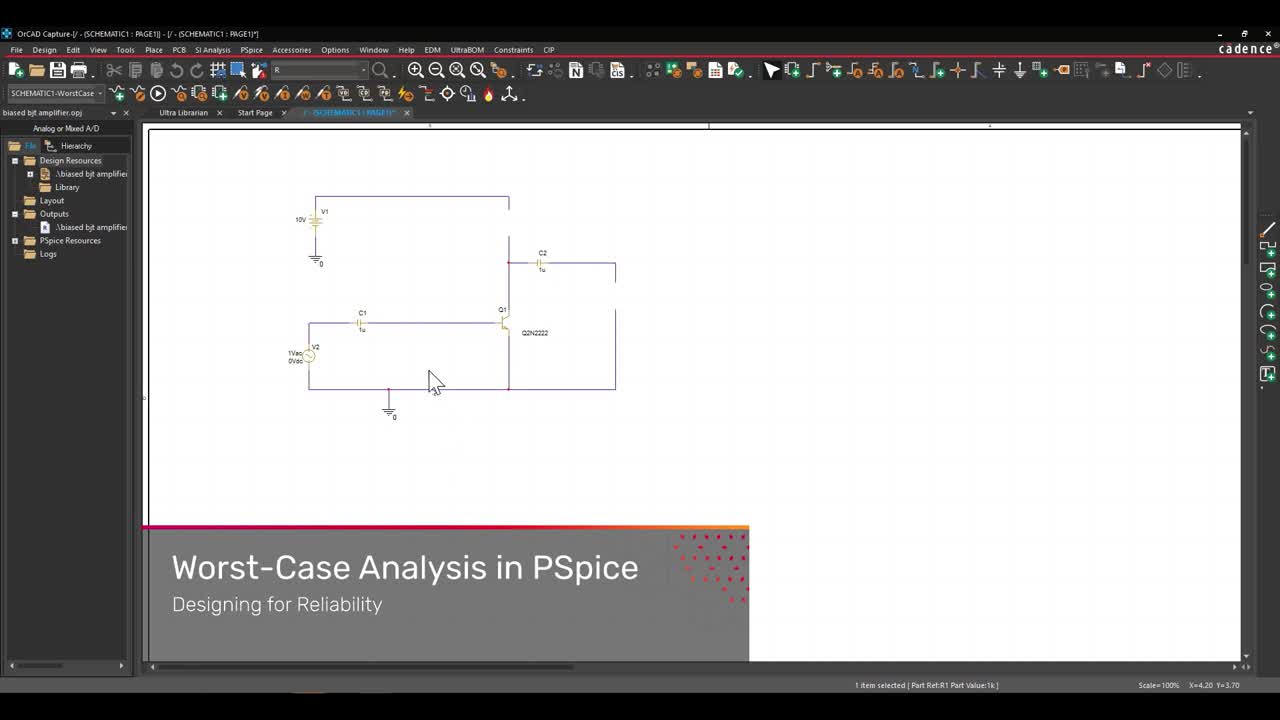What is Worst-Case Circuit Analysis?
There are two ways to evaluate the reliability of your bare circuit board and your PCBA: through testing and simulation. Testing is obviously performed after prototypes are received or during the initial production run with the manufacturer. Simulations should happen on the front end so that potential performance problems can be identified before prototypes are produced. Some simulations are easy to perform and they can eliminate a prototype run, which can be costly and lead to significant redesign requirements.
One circuit simulation methodology that can be implemented in SPICE is worst-case circuit analysis, or simply worst-case analysis. The idea is simple: determine the absolute worst case operation of a circuit given some random variations in component values, input power, or temperature. In this article, we’ll give an overview of the core concepts involved in worst-case analysis and some examples.
Core Concepts in Worst Case Analysis
The purpose of worst-case analysis is to determine the worst expected possible circuit performance. There are three main factors that can cause a circuit’s performance to deviate from its ideal behavior:
- Component tolerances
- Power fluctuations
- Operating temperature of components
SPICE simulations can easily account for any of these factors during operation. Normally you might do this with a parameter sweep during any of the standard SPICE analyses (transient analysis, AC sweep, DC sweep). SPICE simulations are unable to consider other performance aspects that depend on the PCB layout. Examples include reception of EMI and crosstalk, although these can be considered in more complex models. Therefore, the three factors listed above are normally considered in SPICE simulations used for worst-case analysis.
Worst Case Analysis Process
The simulation process for worst-case analysis follows the flowchart shown below. This flowchart shows how extreme operational values are used to identify which solution produces the worst possible performance behavior.
Here we can see that there is approximately 2^N solutions for a system with N components, assuming we only vary component values. The solution space in these problems can be very large in complex circuits. There are more advanced algorithms that can learn how to converge to the worst case performance by implementing sensitivity analysis during simulation, but SPICE simulations are generally brute-force calculations.
How Likely is the Worst Case?
This is a complicated question that is best determined through Monte Carlo simulations as well as a worst-case analysis simulation. Remember, Monte Carlo is used to randomly synthesize circuit behaviors by generating random component values. You can use that data to conduct a statistical analysis for the circuit or system you’re investigating with the goal of getting a probability distribution describing your circuit’s electrical behavior (in this case, it’s whatever important electrical performance parameter you’ve investigated in the worst-case simulations).
You can get the probability distribution from Monte Carlo data by binning it in a histogram. An example with a simple low-pass filter is shown below. In this example, we can see the variation from the Monte Carlo results along the rising edge of the passband.
Example Monte Carlo results that can be compared with worst-case analysis results (10 runs shown).
If we’ve defined the minimum required performance to be no more than -3 dB attenuation below at or above 780 Hz, we can immediately see which curves will not pass our performance requirements. This means the cyan, purple, and blue curves will fail. The probability that the attenuation exceeds -3 dB at the required frequency limit can be determined statistically by constructing a histogram, then you can see where the worst-case result falls on that histogram.
The worst-case analysis portion is effectively automated in the SPICE package because now you don’t need to manually enter in the worst-case component, power, or temperature values you would expect in the system. The SPICE package can handle these points for you.
Other Reliability Simulations
Worst-case circuit analysis is used in the specific situation where you need to estimate the absolute largest statistically significant deviation from a system’s ideal behavior. It’s a good way to evaluate a system’s worst-case performance against specific performance limits. However, there are other important reliability simulations you can use to qualify your system:
- Smoke analysis - this is used to determine stress levels throughout a circuit and identify which components should be swapped for higher power ratings
- Sensitivity analysis - this is similar to worst-case analysis, but it involves varying circuit parameters through some range and determining the corresponding circuit behavior
- Monte Carlo analysis - this simulation generates component values randomly within some tolerance interval so that expected variations in electrical behavior can be determined
Together, these circuit simulation methods give you a very clear view of reliability and variations in expected electrical performance. Development of analog circuits relies heavily on these simulations to ensure required performance levels are met.

When you need to assess the reliability of your electronics, use the circuit design and analysis features with a built-in worst case circuit analysis simulation package in PSpice, the industry’s best circuit simulation software from Cadence. PSpice users can access a powerful SPICE simulator as well as specialty design capabilities like model creation, graphing and analysis tools, and much more.
Subscribe to our newsletter for the latest updates. If you’re looking to learn more about how Cadence has the solution for you, talk to our team of experts.